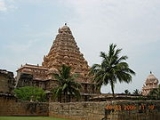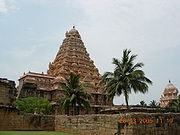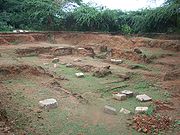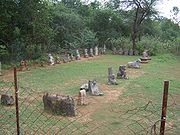
Gangaikonda Cholapuram
Encyclopedia

Tamil language
Tamil is a Dravidian language spoken predominantly by Tamil people of the Indian subcontinent. It has official status in the Indian state of Tamil Nadu and in the Indian union territory of Pondicherry. Tamil is also an official language of Sri Lanka and Singapore...
: கங்கைகொண்ட சோழபுரம்) was erected as the capital of the Cholas by Rajendra Chola I
Rajendra Chola I
Rajendra Chola I was the son of Rajaraja Chola I and was one of the greatest rulers of Tamil Chola dynasty of India. He succeeded his father in 1014 CE as the Chola emperor...
, the son and successor of Rajaraja Chola, the great Chola who conquered a large area in South India at the beginning of the 11th century C.E. It occupies an important place in the history of India. As the capital of the Cholas from about 1025 C.E. for about 250 years, the city controlled the affairs of entire south India, from the Tungabhadra in the north to Ceylon in the south. The great temple of Siva
Shiva
Shiva is a major Hindu deity, and is the destroyer god or transformer among the Trimurti, the Hindu Trinity of the primary aspects of the divine. God Shiva is a yogi who has notice of everything that happens in the world and is the main aspect of life. Yet one with great power lives a life of a...
at this place is next only to the Brihadisvara temple at Thanjavur in its monumental nature and surpasses it in sculptural quality.
Origins of the City

Rajendra Chola-I (1012-1044 A.D) son of the Great Rajaraja-I, established this temple after his great victorious march to river Ganges on Northern India. He was originally called Madurantakan. He assumed the title of Rajendra during his coronation and continued to rule along with his father Rajaraja-I for a while. He was awarded the supreme title of the Cholas known as Parakesari.
Rajendra-I, a great warrior, assisted his father in numerous expeditions to elevate the Cholas to supreme power. The various expeditions he conducted, were : Gangetic expedition, eastern/Western Chalukyas
Western Chalukyas
The Western Chalukya Empire ruled most of the western Deccan, South India, between the 10th and 12th centuries. This dynasty is sometimes called the Kalyani Chalukya after its regal capital at Kalyani, today's Basavakalyan in Karnataka and alternatively the Later Chalukya from its theoretical...
expedition, war against Cheras/Pandyas, Ceylon expedition, Kataram (currently called as Kedah) expedition.
His empire included the whole of southern India to the river Thungabathra in the north. For administrative and strategic purposes he built another capital and named it Gangaikondacholapuram. The Gangaikondacholapuram temple, he constructed consists of 3 stories and was surrounded by a huge fort like wall, the outer wall greatly destructed during the English rule (1896 A.D) to reuse the building material (Granite rocks) for constructing the Lower Anicut (Dam across river Kollidam). He built around 10 temples at various places.
He assumed the title of Gangaikonda Cholan and named his new capital as Gangaikondacholapuram and he also constructed a huge Lake known as Chola Gangam that spreads 22 km mainly used for drinking and irrigation. A statue of Rajendra-I is found in Kolaram temple at Kolar of Karnataka state in India.
C. 1022 C.E. Rajendra undertook an expedition to the Ganges along the east coast of peninsular India. The emperor himself lead the army up to the banks of the Godavari river. The Chola armies conquered all the countries north of Vengi
Vengi
The Vengi kingdom extended from the Godavari River in the north to Mount Mahendragiri in the southeast and to just south of the banks of River Krishna in the south of India. This area was part of Kalinga until that kingdom was conquered by Emperor Ashoka of the Mauryan Empire in the mid 3rd century...
, which included Kalinga
Kalinga (India)
Kalinga was an early state in central-eastern India, which comprised most of the modern state of Orissa/Utkal , as well as the Andhra region of the bordering state of Andhra Pradesh. It was a rich and fertile land that extended from the river Damodar/Ganges to Godavari and from Bay of Bengal to...
, Odda, Southern Kosala, the lower and upper Lada and finally the Vangaladesa (Bengal
Bengal
Bengal is a historical and geographical region in the northeast region of the Indian Subcontinent at the apex of the Bay of Bengal. Today, it is mainly divided between the sovereign land of People's Republic of Bangladesh and the Indian state of West Bengal, although some regions of the previous...
). The triumphant Chola armies brought back waters from the river Ganges in golden vessels. Around the same time, the Cholas under the illustrious Rajendra Chola I
Rajendra Chola I
Rajendra Chola I was the son of Rajaraja Chola I and was one of the greatest rulers of Tamil Chola dynasty of India. He succeeded his father in 1014 CE as the Chola emperor...
also vanquished the Chalukyas of Manyakheta
Manyakheta
Manyakheta on the banks of Kagina River in Gulbarga district, Karnataka state was the capital of Rashtrakutas from . It is 40 km from Gulbarga city. The capital was moved from Mayurkhandi in Bidar district to Mānyakheṭa during the rule of Amoghavarsha I...
when the Chola protectorate of Vengi was threatened by Chalukyas Jayasimha II
Jayasimha II
Jayasimha II , also known by the titles Jagadekhamalla and Mallikamoda, succeeded his brother Vikramaditya V on the Western Chalukya throne. Jayasimha had to fight on many fronts to protect his kingdom...
. Rajendra Chola I defeated Jayasimha-II Chalukya at Maski (Muyangi in Chola anals) between Eluru and Visayavadai (modern Vijayawada) and subsequently engaged the Chalukya in Kannada country itself i.e. in the Chalukyas capital of Mannaikadakkam (Manyakheta) "the war in which the Chalukya Jayasimha-II, full of fear, hid like a mouse and fled the battlefield". The Chola armies seized the Chalukya flag, decapitated or slew various generals of the Chalukyas, with the Chalukyan king fleeing the battlefield. The Chalukya King surrendered his wife to the victorious Chola monarch. With the Chola coffers filling up with riches from the Chalukya country, they were able to establish their hold of the region between the Vaigai/Kaveri delta in Tamil country up to the Tungabhadra
Tungabhadra River
The Tungabhadra River is a sacred river in southern India that flows through the state of Karnataka to Andhra Pradesh, where it serves as the chief tributary of the Krishna River...
-Krishna
Krishna River
The Krishna River , is one of the longest rivers in central-southern India, about . It is also referred to as Krishnaveni in its original nomenclature...
basins in the Maharashtra-Andhra region. To commemorate this celebrated victory, Rajendra assumed the title of Gangaikonda Cholan, "Irattapadi-konda Cholan", "Mannai-kondan" (the king who possessed Irattapadi (erstwhile land of the Rashtrakutas usurped by the Salukkis (Chalukyas) and the king who possessed (the Chalukyan capital) Manyakheta (Mannaikadakkam in Chola annals) and had the Siva Temple Gangakkondacholeswaram built(***). Soon the capital was moved from Thanjavur to Gangaikondacholapuram. The city of Gangaikondacholapuram was probably founded by Rajendra before his 17th year. Most of the Chola kings who succeeded Rajendra were crowned here. They retained it as their capital, reoriented and trained the efficient Chola army.
Chola Dravidian culture
Chola rulers were active patrons of the arts. They flourished in architectures, education, science, arts, ship construction, poetry, drama, music, business trading, dance. The beautiful Nataraja figure was first conceived during the Chola empire.They constructed enormous stone temple complexes decorated inside and out with painted sculptures. While the stone sculptures and the inner sanctum image empowering the temple remained immovable, changing religious concepts during the 10th century demanded that the deities take part in a variety of public roles similar to those of a human monarch. As a result, large bronze images were created to be carried outside the temple to participate in daily rituals, processions, and temple festivals. The round lugs and holes found on the bases of many of these sculptures are for the poles that were used to carry the heavy images. They were admired for the sensuous depiction of the figure and the detailed treatment of their clothing and jewelry in Chola-period bronzes.
Fortifications

The city seems to have had two fortifications, one inner and the other outer. The outer was probably wider. The remains of the outer fortification can be seen as a mound running all around the palace.
The outer fortification built of burnt bricks, was about six to eight feet wide. It consisted of two walls, the intervening space (the core) being filled with sand. The bricks are fairly large in size and are made of well-burnt clay. Systematic brick robbing by the local inhabitants has reduced this structure to its current state.
The outer fortification was known as Rajendra Chola Madil and is mentioned in inscriptions. The inner fortification was around the royal palace, probably identical with the Utpadi vittu madil of the inscriptions.
Probably in the reign of Kulothunga Chola I
Kulothunga Chola I
Kō Rājakēsarivarman Abaya Kulōthunga Chōla was one of the greatest kings of the Chola Empire. He was one of the sovereigns who bore the title Kulottunga, literally meaning the exalter of his race.-Early life:...
, the fortifications were renewed and the city underwent some alteration and additions. An epigraph refers to the fort wall of Kulothunga Chola (Kulottunga Cholan Thirumadil). The strengthening of the fortification and additions to the city in the reign of Kulothunga I were probably necessitated by the uprising which led to the murder of Chola king Athithakarikal Cholain the sambuvaraya's palace of Melakadambur
Melakadambur
Melakadambur is a village located from Chidambaram,and can reach at 6 km from Kattumannarkoil, Cuddalore district, Tamil Nadu, India. It is known for Arulmigu Amirthakateshwarar Thirukkoil, constructed during the reign of Cholas by Kulothunga Chola...
, Kulothunga's predecessor. By the 13th century, the Chola kingdom had exhausted its resources and was on the decline. It succumbed to an attack by the Hoysalas from the west and the Pandyas from the south. The last king of the Medieval Cholas was Rajendra Chola-III.
The Chola Administration
The Chola administration served as a model for all the other kingdoms of the South. The king had a council of ministers. The kingdom was divided into a number of provinces known as mandalams, The mandalams in turn were divided into valanadu and nadus. The next administrative sub divisions were kurrams and kottams.The special feature of the Chola administration was the Local Self Government or the autonomous administration. The villagers themselves carried out village administration. It was more or less like the modern Panchayat Raj. Each village had a village assembly known as the ur or the sabha. The members of the sabha were elected by lot, known as kudavolai system. There was a committee to look after the specified departments, such as justice, law and order, irrigation etc., which were called as variyams.
Architecture

As one steps in, the great Vimana arrests the visitor's sight. The Vimana with its recessed corners and upward movement presents a striking contrast to the straight-sided pyramidal tower of Thanjavur but with octagon shape of Dravidian architecture. As it rises to a height of 182 feet (55.5 m) and is shorter than the Thanjavur tower with larger plinth, it is often described as the feminine counterpart of the Thanjavur temple.
The Vimana is flanked on either side by small temples; the one in the north now housing the Goddess is fairly well preserved. The small shire of Chandikesvara is near the steps in the north. In the north-east are a shire housing Durga, a well called lion-well (simhakeni) with a lion figure guarding its steps and a late mandapa housing the office. Nandi is in the east facing the main shrine. In the same direction is the ruined gopura, the entrance tower. The main tower surrounded by little shrines truly presents the appearance of a great Chakravarti (emperor) surrounded by chieftains and vassals. The Gangaikondacholapuram Vimana is undoubtedly a devalaya chakravarti, an emperor among temples of South India.
Royal Palace

Palace
A palace is a grand residence, especially a royal residence or the home of a head of state or some other high-ranking dignitary, such as a bishop or archbishop. The word itself is derived from the Latin name Palātium, for Palatine Hill, one of the seven hills in Rome. In many parts of Europe, the...
also was built of burnt brick. The ceilings were covered with flat tiles of small size, laid in a number of courses, in fine lime mortar. The pillars were probably made of polished wood, supported on granite bases; a few pillar bases have survived to this day. Iron nails and clamps have been recovered from this palace site.There is a underground tunnel that links the palace and the temple inner 1st pragara(north).
In the reign of Virarajendra Chola
Virarajendra Chola
Virarajendra Chola was one of the most under-rated Chola kings, mainly because a major part of his life was spent in the apprenticeship of his two elder brothers Rajadhirajan Chola I and Rajendra Chola-II, who along with Virarajendra Chola himself were the illustrious sons of their Chakravarti...
, Rajendra's third son, the palace at Gangaikondacholapuram is referred to as Chola-Keralan Thirumaligai (Chola Keralan palace) evidently after one of the titles of Rajendra I. The same inscription mentions a few parts of the palace as adibhumi (the ground floor), Kilaisopana (the eastern portico), and a seat named Mavali vanadhirajan. Evidently the palace was multistoried. In an inscription dated in the 49th year of Kulothunga I (1119 C.E.) reference is made to Gangaikondacholamaligai at this place. It is likely that there were more than one royals building each having their own name.
Expedition to the Ganges
With both the Western and Eastern Chalukya fronts subdued, Rajendra’s armies undertook an extraordinary expedition. 1019 CE Rajendra’s forces continued to march through KalingaKalinga
Kalinga is a landlocked province of the Philippines in the Cordillera Administrative Region in Luzon. Its capital is Tabuk and borders Mountain Province to the south, Abra to the west, Isabela to the east, Cagayan to the northeast, and Apayao to the north...
.
Kalinga was a kingdom in central-eastern India, which comprised most of the modern state of Orissa, as well as some northern areas of the bordering state of Andhra Pradesh to the river Ganges. The Emperor himself advanced up to the river Godavari
Godavari River
This article is about the river Godavari in India. For other uses, see Godavari The Godavari is a river that runs from western to south India and is considered to be one of big river basins in India to protect the rear of the expeditionary force. The Chola army eventually reach the Pala. The word Pala can refer to many different things: kingdom of Bengal where they met Mahipala. I is considered the second founder of the Pala Empire dynasty. Gopala I established the dynastic rule of the Palas in the middle of the 8th century C.E and defeated him.
According to the Tiruvalangadu Plates, the campaign lasted less than two years in which many kingdoms of the north felt the might of the Chola army. The inscriptions further claim that Rajendra defeated the armies of Ranasura and entered the land of Dharmapala and subdued him and thereby he reached the Ganges and caused the water river to be brought by the conquered kings’ back to the Chola country. The new conquests opened up new roots for the Cholas to head for distant lands like Burma by land (through what are now modern Orissa, West Bengal, Assam and Bangladesh).
It is true that Rajendra's army defeated the kings of Sakkarakottam and Dhandabhukti and Mahipala. These territories were initially added to the kingdom, while later they had the status of tribute paying subordinates and trade partners with the Chola Kingdom, an arrangement that lasted till the times of Kulothunga-III and to a limited extent, of Raja Raja-III too. It was undoubtedly an exhibition of the power and might of the Chola empire to the northern kingdoms. But the benevolent leadership of the Cholas treated them in a benevolent manner and did not permanently annexe them to the Chola dominions.
Overseas conquests
Before the fourteenth year of Rajendra’s reign c. 1025, the Chola Navy crossed the ocean and attacked the Srivijaya kingdom of Sangrama Vijayatungavarman. Kadaram, the capital of the powerful maritime kingdom, was sacked and the king taken captive. Along with Kadaram, Pannai in present day Sumatra and Malaiyur in the Malayan PeninsulaThe Malay Peninsula or Thai-Malay Peninsula is a major peninsula located in Southeast Asia. It is also known as the Kra Peninsula and runs approximately north-south through the Kra Isthmus peninsula were attacked. Kedah (now in modern Malaysia) too was occupied.
Sangarama Vijayatungavarman was the son of Mara Vijayatungavarman of the Sailendra dynasty. Srivijaya kingdom was located near Palembang. Palembang is a city of 1,286,000 in the south of the Indonesian island of Sumatra. It is the capital of the Provinces of Indonesia of South Sumatra and its metropolitan area includes more than 1,730,000 people in Sumatra.
There are no records to explain the nature of and the reason for this naval expedition. The Sailendra dynasty had been in good relations with the Chola Empire during the period of Rajaraja Chola I. Rajaraja encouraged Mara Vijayatungavarman to build the Chudamani Vihara at Nagapattinam. Rajendra confirmed this grant in the Anaimangalam grants showing that the relationship with Srivijaya was still continued be friendly. The exact cause of the quarrel that caused the naval war between Cholas and Srivijaya remains unknown.
The Cholas had an active trade relationship with the eastern island. Moreover the Srivijaya kingdom and the South Indian empires were the intermediaries in the trade between China. China is a Culture of China, an ancient civilization, and, depending on perspective, a national or multinational entity extending over a large area in East Asia and the countries of the Western world. Both the Srivijaya and Cholas had active dialog with the Chinese and sent diplomatic missions to China.
The Chinese records of the Song Dynasty Song Dynasty. The Song Dynasty was a ruling Chinese dynasty in China between 960–1279 AD; it succeeded the Five Dynasties and Ten Kingdoms Period, and was followed by the Yuan Dynasty show that first mission to China from Chu-lien (Chola) reached that country in 1015 C.E. and the king of their country was Lo-ts’a-lo-ts’a (Rajaraja). Another embassy from Shi-lo-cha Yin-to-loChu-lo (Sri Raja Indra Chola) reached China in 1033 C.E. and a third in 1077 C.E. during Kulothunga Chola I Kulothunga Chola reigned from 1070 until 1120 C.E. over the vast Chola Empire. The commercial intercourse between Cholas and the Chinese were continuous and extensive.
Rajendra Coin.
One reason could be a trade dispute stemming from some attempts by Srivijaya to throw some obstacle between the flourishing trade between China and the Cholas. Whatever the actual cause of this expedition, it is difficult to believe that, even if we take all the achievements narrated in Rajendra’s inscriptions are accepted as literally true, the campaign led to any permanent territories rather than a vague acceptance of the Chola suzerainty by Srivijaya. Sangaram Vijayatungavarman was restored to the throne at his agreement to pay periodic tribute to Rajendra.
Tanjavur inscriptions also state that the king of Kambhoja (Kampuchea) requesting Rajendra’s help in defeating enemies of his Angkor. Angkor is a name conventionally applied to the region of Cambodia serving as the seat of the Khmer empire that flourished from approximately the ninth century to the fifteenth century A.D kingdom.
Roads and City gates

City layout
The epigraphs also refer to the Madhurantaka Vadavaru, now called the Vadavaru, running about six kilometers east of the ruined capital. Madhurantaka Vedavaru, named after one of the titles of Rajendra I, was a source of irrigation to a vast stretch of land bordering the capital. An irrigation channel called Anaivettuvan is also mentioned."Anaivettuvan" - Anai means irrigation (step irrigation) vettuvan means labour or engineer. Hence the above seque is not matching, more over Hindu dharam never allows to kill elephant.Another possible meaning of "AnaiVettuvan" - Anai means Dam, vettuvan means constructor(labour or engineer).
There were both wet and dry lands inside the Fort, used for cultivation and other purposes. The present positions of the existing temples throw some light on the lay out of the city. With the palace as the centre to the city, the great temple, and the other temples in the city seem to have been erected. Towards the northeast (Isanya) of the palace is the great temple of Siva. The Siva temple according to Vastu and traditional texts should be in the northeast of the city or village and should face east. The temple of Vishnu
Vishnu
Vishnu is the Supreme god in the Vaishnavite tradition of Hinduism. Smarta followers of Adi Shankara, among others, venerate Vishnu as one of the five primary forms of God....
should be in the west.
A number of small tanks and ponds mentioned in inscriptions and a number of wells, supplied drinking water to the residents.
External links
- Maligai Medu - Buried in Time
- Gangaikondacholapuram a symbol of World Heritage
- http://en.wikipedia.org/wiki/Kulothunga_Chozhapuram
- Utthiramerur - Town with inscriptions about Cholas internal administration and election processUttiramerurUttiramerur is a small town situated near Chennai , India. Uttiramerur, once known as Chaturvedhi Mangalam , followed a highly organised democratic system. Uttiramerur is located 35 km from Kanchipuram...
(***) www.whatsindia.com/south_indian_inscriptions (Big Temple, Tanjore)

